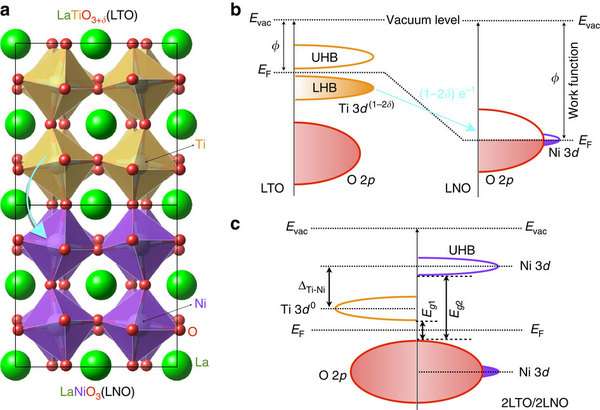Crystal and band structures of 2LTO/2LNO. Credit: Nature Communications (2016). DOI: 10.1038/ncomms10418
Physicists at the University of Arkansas and their collaborators have created a magnetic state in a few atomic layers of artificially synthesized materials known as transition metal oxides.
The research team published its findings on Thursday, Jan. 21, in Nature Communications, an online journal published by the journal Nature.
"The key to the next generation of electronics is fabricating transistors that are multifunctional, meaning that a single electric pulse should be able to trigger multiple actions. For example, they can transition between electronic and magnetic states," said Jak Chakhalian, a professor of physics who directs the Artificial Quantum Materials Laboratory at the U of A.
"This work opens the door to devices based on junctions of correlated electronic materials beyond our current semiconductor devices," he said.
Yanwei Cao, a postdoctoral physics research associate in the Artificial Quantum Materials Lab, found a way to produce a novel magnetic state in a few atomic sheets of a transition metal oxide comprised of lanthanum and titanium and nickel. He conducted the experiments at the University of Arkansas and Advanced Photon Source at Argonne National Laboratory near Chicago.
The research team included U of A postdoctoral research associates Michael Kareev and Srimanta Middey, doctoral student Xiaoran Liu and recent doctoral graduate Derek Meyers, now at Brookhaven National Laboratory. The team also included Debashish Chowdhury at the Indian Institute of Technology in Kanpur, India; and John W. Freeland, Phillip Ryan and Jong-Woo Kim of the Advanced Photon Source.
More information: Yanwei Cao et al. Engineered Mott ground state in a LaTiO3+δ/LaNiO3 heterostructure, Nature Communications (2016). DOI: 10.1038/ncomms10418
Journal information: Nature Communications
Provided by University of Arkansas





















